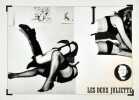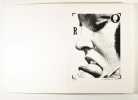3546 books for « roman »Edit
-
Type
Autograph (7)
Book (3508)
Magazine (13)
Music sheets (16)
Posters (4)
-
Latest
Last 3 days (2)
Last month (20)
Last week (8)
-
Language
French (3463)
German (5)
Russian (79)
Spanish (1)
-
Century
17th (1)
18th (6)
19th (42)
20th (504)
21st (159)
-
Countries
Belgium (62)
Canada (9)
China (2)
Côte d'Ivoire (3)
Denmark (15)
France (3244)
Germany (1)
Switzerland (133)
United States of America (79)
-
Syndicate
ALAC (8)
CLAM (2)
CLAQ (2)
ILAB (442)
NVVA (18)
SLACES (18)
SLAM (388)
SNCAO (1)
Topics
- Adam (10)
- Alps (23)
- Alsace (102)
- Aragon (8)
- Archaeology (11)
- Architecture (9)
- Arrabal (5)
- Autographs (12)
- Bazin Hervé (9)
- Bibliography (7)
- Bibliophilism (6)
- Biography (12)
- Brittany (6)
- Cathedrals (7)
- Cesbron gilbert (8)
- Chapsal madeleine (10)
- Children’s books (8)
- Cinema (39)
- Civilisation (5)
- Comic strip (23)
- Curiosa (6)
- Dauphiné (8)
- Detective novels (24)
- Dictionaries (13)
- Drawings (5)
- Economics (9)
- Education (5)
- Egypt (7)
- Esotericism (5)
- Fajans (8)
- Fine arts (25)
- First edition (23)
- Flora (5)
- Fox (5)
- Gard (6)
- Geography (9)
- Geology (6)
- Germanic languages (11)
- Guittoneau ben (5)
- Hackney (6)
- Helvética (16)
- Historical novel (23)
- History (76)
- Humour anecdotes (9)
- Industrial arts & crafts - fine arts (8)
- Iran - persia (12)
- Italy (8)
- Jacob (8)
- Jakobson roman (37)
- Languedoc (10)
- Lanzmann jacques (8)
- Law (6)
- Linguistics (13)
- Literature (2813)
- Middle ages (16)
- Miller (9)
- Navy (12)
- Paris (18)
- Philosophy (19)
- Photography (13)
- Poetry (12)
- Poland (12)
- Policy (7)
- Posters (14)
- Protestantism (6)
- Provence (5)
- Psychology (6)
- Queneau raymond (6)
- Raphael (7)
- Regionalism (11)
- Reims (7)
- Religions (9)
- Review (19)
- Reviews (9)
- Romanic art (24)
- Sagan françoise (11)
- Sciences (8)
- Scores (21)
- Shapes & colours (6)
- Simone (7)
- Songs (17)
- Suspense (7)
- Switzerland (18)
- Theatre (16)
- Troyat henri (18)
- Ussr (7)
- Various (70)
- War (24)
- Youth (6)
- Zodiac (7)
Acta Apostolicae Sedis Commentarium Officiale
Romae Typis Polyglottis Vaticanis 1909
First edition. Volumes 1-5 of the Acta Apostolicae*. Vol.1 : 1909 (21 issue: Annus 1) - 20 December 1909 num. 21) / Vol 2 : 1910 (21 issues: Annus 2 20 Jan 1910 num. 1 - 19 December 1910 num. 23) / Vol 3 : 1911 (17 issues: Annus 3 - 16 Jan 1911 num. 1 - 20 December 1911 num. 17 / Vol 4 : 1912 (22 issues: Annus 4 - 15 January 1912 num. 1 - 30 December 1912 num. 22) / Vol. 5 : 1913 (19 Issues: Annus 5 - 25 Jan 1913 issue 1 - 31 December 1913 num. 19) Vol 1 & 2 have White 3/4 cloth with green boards. Vol 3-5 have white vellum. black leather labels with gilt titles. Internally mainly clean and tidy, with a little darkening to the page edges. Volume one has a little rubbing to the spine edges. Frontis portrait of Pope Pius X to volume 1. These volumes came from the St Birgittae de Sion (Bridgettine) monastery at Chudleigh in Devon. They were donated to the Abbey (and each has an inscription stating this) by the Rev. Benedict Williamson. Wiliamson was a prominent Catholic Architect, and supporter of the Bridgetinnes. He was ordained a priest in 1909 and was behind many of the finest early 20th Century Catholic Churches. *Acta Apostolicae Sedis (Latin for "Acts of the Apostolic See"), often cited as AAS, is the official gazette of the Holy See, appearing about twelve times a year. It was established by Pope Pius X on 29 September 1908 with the decree Promulgandi Pontificias Constitutiones, and publication began in January 1909. It contains all the principal decrees, encyclical letters, decisions of Roman congregations, and notices of ecclesiastical appointments. The laws contained in it are to be considered promulgated when published, and effective three months from date of issue, unless a shorter or longer time is specified in the law
A Vanished World.
London Allen Lane 1984
Second printing of this fascinating photo-book. In hardback in brown boards, under original unclipped dust jacket. Foreword by Elie Wiesel, himself a Jewish prisoner in the Auschwitz and Buchenwald concentration camps. This book is illustrated with a comprehensive selection (180) of Vishniac's celebrated photographs of the Jews of Eastern Europe in the lead up to World War Two. Many of the photos are are full-page. The images were taken secretly, under difficult circumstances, between 1934 and 1939, and the negatives smuggled out sewn in to clothing etc. It is not an over statement to say that these photographs remain important to preserve for posterity unforgettable images of pre-war Jewish life. Unpaginated [96 pages]. 315 x 315 mm
LE GENIE DE PETRARQUE OU IMITATION en vers françois de ses plus belles poésies.précédé de la vie de cet homme célèbre , dont les actions et les écrits font une des plus singulières époques de l'histoire & de la littérature moderne.
1778 PARME et AVIGNON J.GUICHARD 1778. petit in-8, vj-390 pp., 1f. n. ch., , cartonné époque ,dos lisse et plats (coiffes , charniéres et coins émoussés) , édition originale; les 288 premières sont consacrées à l'intéressante biographie de Pétrarque par l'abbé Roman, né en Avignon.
tranches rouges ,traces de mouillures claires en marge à 2 feuillets ,rare Remise de 20% pour toutes commandes égales ou supérieures à 100 €
De Militia Romana libri qvinqve. Commentarius ad Polybium. Editio ultima. (+) Poliorceticon sive de Machinis. Tormentis. Tellis. Libri qvinqve. Ad Historiarum lucem. Editio tertia, correcta & aucta.
Antverpen, Ex Officina Plantiniana, Apud Viduam & Filios Ioannis Moreti, 1614. - (Second work:) Ex Officina Plantiniana, Apud Ioannem Moretum., 1605. Large 4to. Contemp. full vellum over wood, fully intact. Some scratches and brownspots to covers.Front free endpaper missing. Engraved printers device (Plantin) at titlepage. 397,(6) pp, 1 double-page engraved plate, 3 full-page engravings, 7 large textengravings, many woodengraved illustrations in the text.Wood-engraved initials. First 4 leaves a bit frayed in outer margin (but margins wide). Light yellowing to leaves, a few insignificant brownspots. Poliorceticon: Engraved printers device (Plantin) at titlepage. 219,(7) pp. 25 full-page engraved illustrations, 11 half-page engravings, wood-cut initials. Printers large wood-cut device at end. The 5 last leaves frayed in outer margins (margins wide). Light yellowing to leaves.
The volume contains Justus Lipsius's two importent works on Roman military history in the fine printings from the Plantin office. ""De Militia Romana"", first published in 1595, is a commentary on Polybius's ""History"", with the Greek text and a parallel Latin translation. ""Poliorcetica"" (1599) is a study of the Roman machinery of war. Both works are illustrated with the fine engravings of Peeter vander Borcht and Theodore Galle.""His (Lipsius) throughout acquaince with Latin literature and Roman history is conspicuous in his numerous treatises, especially in those entitled ""De Militia Romana"" and ""Poliorcetia"" (the former including a commentary on the Roman Camp as described by Polybius)..."" (Sandy II, p. 304).Cockle: 620 a. 672.
Todorov (Tzvetan), ed. - Roman Jakobson - B. Eikhenbaum - V. Chklovski - V.V. Vinogradov - J. Tynianov - O. Brik - B. Tomachevski - V. Propp
Reference : 85544
(1966)
"Théorie de la littérature - Textes des Formalistes russes réunis, présentés et traduits par Tzvetan Todorov, préface de Roman Jakobson (Formalisme en Russie) , (Vers une science de l'art poétique - 1. La théorie de la méthode formelle - L'art comme procédé - Du réalisme artistique - Des tâches de la stylistique - La notion de construction - De l'évolution littéraire - Le problème des études littéraires et linguistiques - 2.Rythme et syntaxe -Sur le vers - La construction de la nouvelle et du roman - Sur la théorie de la prose - Comment est fait ""Le manteau"" de Gogol - Les transformations des contes merveilleux - Thématique)"
Editions du Seuil , Tel Quel Malicorne sur Sarthe, 72, Pays de la Loire, France 1966 Book condition, Etat : Bon broché, sous couverture imprimée éditeur blanche, encadrée de marron sur le plat supérieur grand In-8 1 vol. - 317 pages
1ere édition, 1966 "Contents, Chapitres : Roman Jakobson : Vers une science de l'art poétique - Présentation (30 pages) - 1. B. Eikhenbaum : La théorie de la méthode formelle - V. Chklovski : L'art comme procédé - R. Jakobson : Du réalisme artistique - V.V. Vinogradov : Des tâches de la stylistique - J. Tynianov : La notion de construction - De l'évolution littéraire - J. Tynianov et R. Jakobson : Le problème des études littéraires et linguistiques - 2. O. Brik : Rythme et syntaxe - B. Tomachevski : Sur le vers - V. Chklovski : La construction de la nouvelle et du roman - B. Eikhenbaum : Sur la théorie de la prose - Comment est fait ""Le manteau"" de Gogol - V. Propp : Les transformations des contes merveilleux - B. Tomachevski : Thématique - Note bibliographique, sur les auteurs, index - Le terme formalisme russe désigne une école de linguistes et de théoriciens de la littérature qui, de 1914 à 1930, révolutionna le domaine de la critique littéraire en lui donnant un cadre et une méthode novatrice. On peut distinguer le groupe de Moscou mené par Roman Jakobson, et celui de Saint-Pétersbourg, l'OPOYAZ, conduit par Victor Chklovski. Les formalistes russes auront une influence considérable sur la sémiologie et la linguistique du XXe siècle, notamment par le biais du structuralisme. - Ce courant de critique littéraire se développe en Russie entre 1915 et 1930, mais ce mouvement n'a été découvert en France que vers 1960. Il commence par la création en 1915 du Cercle linguistique de Moscou pour « Promouvoir la linguistique et la poétique ». Il est aidé ensuite par la collaboration de l'OPOYAZ, qui aide les formalistes par l'apport des poètes futuristes comme Vladimir Maïakovski. La revue Poetica est publiée avec l'aide des formalistes par l'institut d'État d'histoire des arts. Le mot « formaliste » est d'abord une critique qui leur est adressée, mais dont ils se défendent, affirmant préférer « les qualités intrinsèques du matériau littéraire ». - Le formalisme naît en réaction contre une méthode de critique qui s'attachait à l'étude des symboles et d'éléments qui influencent l'uvre (l'histoire, la société...). Contre cette manière de faire, les formalistes proposent d'étudier la littérarité (« Ce qui fait d'une uvre une uvre littéraire », selon Jakobson). Ainsi les formalistes étudient en détail la structure des uvres, les personnages, la structure précise du vers. L'histoire littéraire est révisée à partir d'une dialectique proche du marxisme. (source : Wikipedia)" legeres petites taches sur le plat inférieur et la tranche supérieure (un peu plus sombres) n'affectant pas l'intérieur, sinon bon état, intérieur frais et propre, cela reste un bon exemplaire
Le Roman De Renart - Le Roman De La Rose / analyse et Meilleures Pages
La Renaissance Du Livre broché Couverture Illustrée Paris "collection "" tous les chefs d' oeuvre de la littérature française "" - 159 pages en format 11.5 - 17.5 cm"
Très Bon État
Serrate silver denarius. - [MAGNIFICENT ROMAN COIN DEPICTING ODYSSEUS ]
Rome, minted in 82 BC. 20mm. 3.74 g. Avery nice specimen, with clear imprint and light rubbing. Obverse: Draped bust of Mercury right, wearing winged petasos caduceus and control letter behind. Reverse: Ulysses standing right, holding staff in left hand and extending right hand to Argus C•MAMIL to left, LIMETAN to right. Crawford 362/1 BMCRR Rome 2725" RSC Mamilia 6.
A denarius of the Roman Republic featuring one of the very few references to Homer's Odyssey in ancient coinage. On the obverse is Mercury, a god very much propitious to Odysseus, easily recognizable by the winged petasos and the caduceus. The reverse depicts one of the most moving passages in literature, hardly matched to this day. In book XVII (290-327) Odysseus returns to Ithaca disguised as a beggar. His faithful dog, Argos, has been waiting for his return for 20 years. Ignored, abandoned by everyone, the dog is ridden with ticks and fleas, lying in a pile of manure. Odysseus is accompanied to the palace by Eumaeus the shepherd, who is unaware of the beggar's true identity. Odysseus recognizes his dog and is forced to hide a single tear that rolls down his cheek. He cannot greet the dog, as that would give away his identidy. Argos, after all those years, recognizes his master as well, but if he were to run to him it would most certainly cause his death by the suitors. Here Homer cannot do anything other than to end the life of Argos, otherwise the entire Odyssey would have been for naught. So Argos dies upon the vision of his master having fulfilled his life purpose: to await his return. It is also the moment that marks the end of the twenty year cycle since Odysseus left for the Trojan War, thus announcing the imminent closing of the Trojan Cycle itself. The denarius' reverse depicts the idealized moment of the scene where master and dog would be just about to meet and greet each other, but as we have seen, the reunion cannot happen. ""There lay the hound Argos, full of vermin"" yet even now, when he marked Odysseus standing near, he wagged his tail and dropped both his ears, but nearer to his master he had no longer strength to move. Then Odysseus looked aside and wiped away a tear. [...] But as for Argos, the fate of black death seized him straightway when he had seen Odysseus in the twentieth year."" Mamilius Limetanus is one of the three moneyers for the year 82 BC. The moneyers, selected every year, were magistrates in charge of the production of coinage, and they were at liberty to determine the design of the coins, which were often deities and characters associated with their personal family history. Like most Roman Patricians, Limetanus claimed to be a descendant of a Homeric character, in this case, Odysseus—Julius Caesar's family, for example, thought themselves to be descendants of Aeneas. A wonderful specimen of this magnificent Roman denarius.
ROMAN. N° 4. (Septembre 1951).
ROMAN. N° 4. (Septembre 1951). Franco Fortini, Rose Celli, Jean-Pierre Monnier, Pierre de Lescure, Stig Dagerman, etc. Très bon état.
ROMAN. Saint-Paul (Alpes-Maritimes) puis Paris. Directeurs : Pierre de Lescure et Célia Bertin. Grand in-8° broché. Couverture composée par Henri Matisse. 12 numéros (dont un double, le n° 6-7) ont paru en 11 livraisons, de janvier 1951 à juillet 1955.
ROMAN. N° 6-7. (Avril 1952).
ROMAN. N° 6-7. (Avril 1952). C.-G. Bjurstrom, Vilgot Sjoman, Clarisse Francillon, Claudio Varese, etc. Très bon état.
ROMAN. Saint-Paul (Alpes-Maritimes) puis Paris. Directeurs : Pierre de Lescure et Célia Bertin. Grand in-8° broché. Couverture composée par Henri Matisse. 12 numéros (dont un double, le n° 6-7) ont paru en 11 livraisons, de janvier 1951 à juillet 1955.
ROMAN. N° 5. (Novembre 1951).
ROMAN. N° 5. (Novembre 1951). Erik de Mauny, Fedor Sologoub, Pierre de Lescure, Vilgot Sjoman, etc. Très bon état.
ROMAN. Saint-Paul (Alpes-Maritimes) puis Paris. Directeurs : Pierre de Lescure et Célia Bertin. Grand in-8° broché. Couverture composée par Henri Matisse. 12 numéros (dont un double, le n° 6-7) ont paru en 11 livraisons, de janvier 1951 à juillet 1955.
ROMAN. N° 12. (Juillet 1955).
ROMAN. N° 12. (Juillet 1955). Célia Bertin, Guy Vaes, Robert Guiette, Pierre Algaux, Anne Bodart, Axel Amlie, Sigurd Hoel, etc. Très bon état.
ROMAN. Saint-Paul (Alpes-Maritimes) puis Paris. Directeurs : Pierre de Lescure et Célia Bertin. Grand in-8° broché. Couverture composée par Henri Matisse. 12 numéros (dont un double, le n° 6-7) ont paru en 11 livraisons, de janvier 1951 à juillet 1955.
ROMAN. N° 1. (Janvier 1951).
ROMAN. N° 1. (Janvier 1951). Virginia Woolf, Joan Bennett, Rose Celli, Pierre de Lescure, Célia Bertin, William Sansom, Jacques Corbier, etc. Long article non signé (probablement de Pierre de Lescure) sur James Joyce. Bon état.
ROMAN. Saint-Paul (Alpes-Maritimes) puis Paris. Directeurs : Pierre de Lescure et Célia Bertin. Grand in-8° broché. Couverture composée par Henri Matisse. 12 numéros (dont un double, le n° 6-7) ont paru en 11 livraisons, de janvier 1951 à juillet 1955.
ROMAN. N° 3. (Juin 1951).
ROMAN. N° 3. (Juin 1951). James Joyce (fragment de Finnegans wake), Elio Vittorini, Franco Lucentini, Alan Ross, Pierre de Lescure, Claus Pack (" Analogies : Joyce, Picasso, Klee "), Maxime Chastaing (" Tentatives pour une traduction de Finnegans wake "), etc. Bon état.
ROMAN. Saint-Paul (Alpes-Maritimes) puis Paris. Directeurs : Pierre de Lescure et Célia Bertin. Grand in-8° broché. Couverture composée par Henri Matisse. 12 numéros (dont un double, le n° 6-7) ont paru en 11 livraisons, de janvier 1951 à juillet 1955.
Église catholique , Roman Catholic Church Missale Romanum RELIURE ANIMEE plaques romantique
Reference : 24603
(1853)
Missale Romanum ex decreto sacrosancti concilii Tridentini restitutum, S. PII Quinti jussu editum, Clementis VIII. et Urbani VIII. Papae auctoritate recognitum, et novis missis ex indulto apostolico hugusque concessis auctum
1853 P. J. Hanicq, Mechliniae [Malines Mechelen, Flanders, Belgium], 1853,IN FOLIO reliure plein chagrin rouge (posterieure),plats decorés (cartonnage fers dorés,monogramme MM ,2e plat)),tranches dorées,dos à caissons dorés,signets tissus multicolores à fleurs de lys,11 planches gravées ht (bois et litho) - Title vignette; illustrated initials; printed in red and black; text in double columns.[40], 484, cxxxvj,+ [1]-[1-1bl]-2-2-2-20-[1-1bl-2] p.,pages datées posterieures : , 11 unnumbered leaves of plates : illustrations, music ; 36 x 26 cm, RELIURE ANIMEE plaques romantique, bon état .Missale Romanum is a highly important text in the Roman Catholic Church and contains within it the texts and rubrics relating to the Catholic Rite of Mass, considered an essential part of Catholic doctrine. This particular version of the Roman Missal contains the changes made by Pope Clement VIII in 1604 which include corrections to the previous standard edition created by Pope Pius V and the further corrections made by Pop Urban VIII in 1634. The work is an unusual edition of a highly important and still widely recognised part of Catholic Dogma,with last corrections.
In all an impressive good copy in a fine binding.A nice typographical specimen of a 19th century missal illustrated, printed and bound with fine craftmanship by the famous Hanicq press in Mechelen.Liturgy. Remise de 20% pour toutes commandes égales ou supérieures à 100 €
L'ULL CRITIC, 4-5. Roman populaire et / ou roman historique.
Lleida, Universitat de Lleida, Departament de Filologia Francesa..., 1999, in 8° broché, 304 pages.
Textes en français et en espagnol dont Roger Bellet : Erckmann-Chatrian lu par Vallès. Mythologie et idéologie de la Révolution Française. PHOTOS sur DEMANDE. ...................... Photos sur demande ..........................


Phone number : 04 77 32 63 69
[Véronique Jordan-Roman ] - RONSARD Véronique Jordan-Roman
Reference : 44263
ISBN : 2110808284
AMOURS DE MARIE. SONNETS POUR HÉLÈNE. Illustrations de Véronique Jordan-Roman
Paris Imprimerie Nationale 1985 in 8 carré (22,5x17) 1 volume reliure plein cuir rouge de l'éditeur, dos à 4 nerfs soulignés de filets dorés, tête dorée, 365 pages [4], avec de nombreuses illustrations hors-texte en couleurs de Véronique Jordan-Roman. Textes présentés et commentés par Robert Aulotte. Collection '' Lettres Françaises''. Tirage limité à 5100 exemplaires numérotés, celui-ci un des 4980 exemplaires imprimés sur papier d'édition de Rives, et reliés plein cuir. Bel exemplaire ( Photographies sur demande / We can send pictures of this book on simple request )
Très bon Reliure Ed. numérotée
Les Cahiers d'un Chat de Gouttières, au vitriol vitaminé . Petit bréviaire d'hédonisme, d'eudémonisme et d'utilitarisme. ( Avec dédicace de Daniel Roman ).
Editions Jean Grassin 1963. In-8 broché de 200 pages au format 24 x 17 cm. Couvertures illustrées. Dos carré. Plats et intérieur frais malgré de petits frottis aux mors et aux coins. Livre composé de de boutades et d'aphorismes par le chansonnier et poète, Daniel Roman, pensionnaire des Trois Baudets et autres cabarets parisiens. Composition typographique très originale sur papier à carreeux de type " cahier d'écolier " avec illustrations de l'auteur. Edition originale en très bel état général. Exemplaire orné d'une dédicace autographe, signée et datée, de Daniel Roman, effectuée au Cabaret " Le Moulin à Poivre ". Peu courant.
Site Internet : Http://librairie-victor-sevilla.fr.Vente exclusivement par correspondance. Le libraire ne reçoit, exceptionnellement que sur rendez-vous. Il est préférable de téléphoner avant tout déplacement.Forfait de port pour un livre 7 €, sauf si épaisseur supérieure à 3 cm ou valeur supérieure ou égale à 100 €, dans ce cas expédition obligatoire au tarif Colissimo en vigueur. A partir de 2 livres envoi en colissimo obligatoire. Port à la charge de l'acheteur pour le reste du monde.Les Chèques ne sont plus acceptés.Pour destinations extra-planétaire s'adresser à la NASA.Membre du Syndicat Lusitanien Amateurs Morues
LE POSTE DES NEIGES. Roman inédit orné de nombreuses illustrations obtenues par la photographie d'après nature.
Barcelone & Paris, Richardin Lam & Per Lamm, (1899). In-8 de 203pp. & 8 ff. du catalogue de la collection, ill. de nbr. photographiques en noir et blanc in-texte et hors texte. Intérieur très frais. Envoi "A Mademoiselle Souvestre" daté 1900. Demi-veau rouge, plats de papier marbré, couvertures (première restaurée). Reliure moderne.
Edition originale de ce roman photo illustré de photos d'après nature. Collection "Excelsior". Roman alpin situé dans la région de Chambéry, illustré d'après les clichés "mis en scène" du capitaine A. Lonzo. Il était à la mode à cette époque d'utiliser des comédiens pour illustrer des romans. Imprimé sur papier couché.
Russian Fairy Tales.
New York. Pantheon, 1945. In-8 reliure pleine toile éditeur. This is a first edition of Russian Fairy Tales, translated by Norbert Guterman and with Folkloristic commentary by Roman Jakobson. With fourteen colour plate illustrations by A. Alexeieff. Contes traduits par N. Guterman. Commentaires de Roman Jakobson. 14 planches en couleurs et nombreux dessins en noir et blanc d'Alexandre Alexeieff. E.O.
La Conquête d'une belle-mère roman/Margaret Argles Hungerford trad. de l'anglais par Mme Dussaud-Roman
Générique Broché D'occasion état correct 01/01/1903 150 pages
PHOTOGRAPHIE ORIGINALE : PORTRAIT DE MANCOR - GUIDE (1870)
pau ROMAN BANDOWSKI 1870 une photographie originale "CARTE DE VISITE" albuminée en noir et aquarellée en rouge, format : 5,6 x 9 cm pour la photo, 10 x 6,1 cm avec le carton ou la photo est contrecollée, Année : Circa 1870, imprimé au verso : ROMAN BENDOWSKI ARTISTE PEINTRE PHOTOGRAPHE PAU,notée au crayon en haut du verso : Mancor guide,
OMAN BANDOWSKI PHOTOGRAPHE, Activités entre 1860 et 1875 Pau Pyrénées-Atlantiques (64) France ................ TRÉS RARE ................ en bon état (good condition). en trés bon état
Dans la peau du miroir
1988 Bruxelles, La Pierre d’Alun, 1988, 224x166mm, 84pp., en feuilles sous couverture imprimée.Le texte de Marcel Mariën est illustré de 10 photomontages originaux de Roman Cieslewicz.Exemplaire 15/50 réservés aux amis de « La Pierre d’Alun » signés par les auteurs et comportant en frontispice une sérigraphie originale signée et numérotée de Roman Cieslewicz.Exemplaire unique comprenant les dix photomontages originaux, 360x265mm, portant tous au dos le cachet de la vente de l’atelier, l'ensemble contenu dans une boîte spécialement conçue et réalisée par l'Atelier Devauchelle.Roman Cieslewicz commence sa carrière cher « Elle » en 1963 ou il est rapidement nommé directeur artistique ; puis il dirige l’agence M.A.F.I.A. ou il conçoit des campagnes pour Prisunic, Woolmark, 3 Suisses ou Lancaster ; puis il crée la revue « Opus International », la revue « Kitsch » avec Topor et Sternberg, puis commence une longue collaboration avec le Centre Pompidou pour lequel il crée de nombreuses affiches et catalogues. Dans cette collaboration avec Marcel Mariën on reconnait l’influence du surréalisme belge.Provenance des photomontages : vente atelier Cieslewicz, Paris,19 mars 2006 , lot 238.(104095)
Phone number : +33 1 48 01 02 37
( Bibliographie - Bibliophilie ) - Théâtre et Roman Populaire - Collectif.
Reference : 24461
Le Rocambole. Bulletin des Amis du Roman Populaire n° 20 : Théâtre et Roman Populaire.
Bulletin des Amis du Roman Populaire / Revue Le Rocambole n° 20 de 2002. In-8 broché de 175 pages au format 14 x 20 cm. Couverture illustrée. Illustrations. Bibliographie. Livre neuf. Edition originale.
Site Internet : Http://librairie-victor-sevilla.fr.Vente exclusivement par correspondance. Le libraire ne reçoit, exceptionnellement que sur rendez-vous. Il est préférable de téléphoner avant tout déplacement.Forfait de port pour un livre 7 €, sauf si épaisseur supérieure à 3 cm ou valeur supérieure ou égale à 100 €, dans ce cas expédition obligatoire au tarif Colissimo en vigueur. A partir de 2 livres envoi en colissimo obligatoire. Port à la charge de l'acheteur pour le reste du monde.Les Chèques ne sont plus acceptés.Pour destinations extra-planétaire s'adresser à la NASA.Membre du Syndicat Lusitanien Amateurs Morues
L’homme de la jungle. Roman colonial
Paris, Bibliothèque-Charpentier 1929 In-12 19,5 x 12,5 cm. Reliure demi-basane bleu-marine, dos lisse, 228 pp. Exemplaire en bon état.
Bon état d’occasion
Eau-forte originale signée représentant un personnage de la Commedia dell'arte (22 x 16 cm).
(Paris, Les Amis bibliophiles, 1981) 1981 1 vol. Broché Belle eau-forte tirée à 130 exemplaires sur Arches, justifiée et signée par l'artiste. En parfait état.
 Write to the booksellers
Write to the booksellers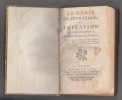



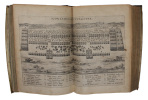



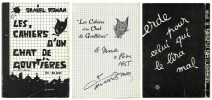
![LE POSTE DES NEIGES. Roman inédit orné de nombreuses illustrations obtenues par la photographie d'après nature.. [ROMAN PHOTO - MONTAGNE] MARGUERITTE ...](https://static.livre-rare-book.com/pictures/BTR/img22791_1_thumb.jpg)
![LE POSTE DES NEIGES. Roman inédit orné de nombreuses illustrations obtenues par la photographie d'après nature.. [ROMAN PHOTO - MONTAGNE] MARGUERITTE ...](https://static.livre-rare-book.com/pictures/BTR/img22791_2_thumb.jpg)
![LE POSTE DES NEIGES. Roman inédit orné de nombreuses illustrations obtenues par la photographie d'après nature.. [ROMAN PHOTO - MONTAGNE] MARGUERITTE ...](https://static.livre-rare-book.com/pictures/BTR/img22791_3_thumb.jpg)

